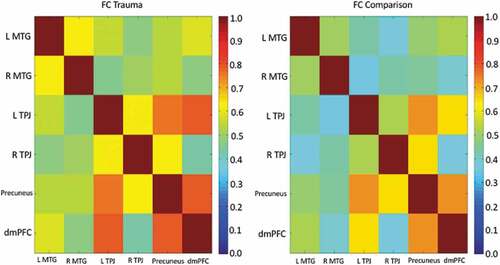Figures & data
Table 1. Demographic and clinical characteristics of the child abuse (CA) and the unaffected comparisons (UC).
Table 2. MNI coordinates and anatomical locations of the identified clusters of seed-based functional connectivity analysis. Child abuse > Unaffected comparisons.
Figure 1. Functional connectivity of seed regions (in larger font, corrected for multiple comparisons) with other brain areas (smaller font) for the Child abuse > Unaffected comparisons contrast. There were no areas for which Unaffected comparisons > Child abuse. TPJ = temporo-parietal junction; dmPFC = dorsomedial prefrontal cortex; MTG = middle temporal gyrus; R, right; L, left.

Figure 2. Correlation matrix (correlation coefficient, r) for the ToM to ToM region-of interest correlations for the trauma group (CA, left panel) and unaffected comparison group (UC, right panel) separately.

Table 3. MNI coordinates and anatomical locations of the identified clusters of seed-based functional connectivity analysis for the main effect of number of abuse types and severity on the CA group.
Figure 3. Functional connectivity of seed regions (in larger font, corrected for multiple comparisons) with other brain areas (smaller font) for the main effect of number of abuse on the CA group. TPJ = temporo-parietal junction; dmPFC = dorsomedial prefrontal cortex; STG = superior temporal gyrus; R, right; L, left.

